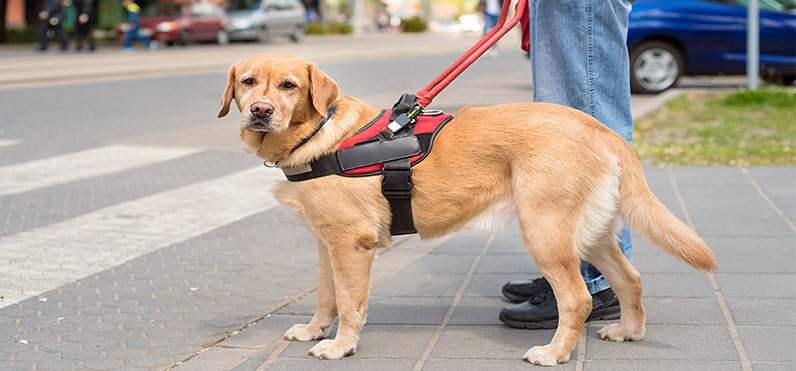Jan 30,2020
On January 28, 2020, HUD issued long-awaited guidance to housing providers on assessing reasonable accommodation requests for assistance animals.
Under federal and state fair housing laws, housing providers, including community associations and landlords and their agents, are required to provide a change to a rule or policy when such an accommodation is necessary to afford a disabled person equal opportunity to use or enjoy their housing. Allowing an assistance animal in a “no pets” building is a common example. In recent years, requests for assistance animals have increased and boards and managers frequently inquire, what documentation can I request? Are online certificates acceptable documentation of a disability and/or disability-related need? What types of animals must we allow? Ferrets? Pitbulls? What if the assistance animal damages the common areas? The new HUD guidance attempts to address some of these questions and provide best practices on assessing reasonable accommodation requests for an assistance animal. (HUD’s FHEO Notice-2020-01 can be accessed by clicking on this link. HUD’s Fact Sheet on HUD’s Assistance Animals Notice can be accessed by clicking on this link).
In recent years, requests for assistance animals have increased and boards and managers frequently inquire, what documentation can I request?
Assessing a Request
The guidance from HUD is framed around 8 questions intended to provide a roadmap for evaluating a request for a reasonable accommodation for an assistance animal, which includes both service animals and other support animals.
To begin, HUD starts with questions to determine if the animal is a service animal: a dog that is trained for the benefit of an individual with a disability. (Questions 1-3). Service animals are protected not only under Fair Housing Laws, but also allowed entry into places of public accommodation under the Americans with Disabilities Act (ADA).
More often, boards and managers receive requests concerning a support animal/comfort animal/companion animal (or other type of assistance animal). We, therefore, turn and dive more deeply into the steps (Questions 4-8) and the guidance HUD offers in evaluating those requests:
The Ask. There must be a request for an accommodation.
HUD’s guidance includes a publication of information for residents seeking an accommodation for assistance animals that should be available to residents, but boards and managers cannot mandate that residents use it to make a request. As we have advised boards and managers in the past, you cannot mandate the use of any specific form. A request does not have to be in writing; nor must it include the words “reasonable accommodation.” It can even be made by someone other than the individual needing the accommodation. Furthermore, the request can be made at any time: before or after move-in, before or after acquiring the assistance animal, before or after a notice of violating a pet-restriction is issued (although the last one will incur a certain presumption against the requestor).
Disability. The resident for whom the request is being made must have a disability and a disability-related need for the accommodation.
• Does the person have an observable disability or does the housing provider (or agent making the determination for the housing provider) already have information giving them reason to believe that the person has a disability? (Question 5).
• If no, has the person requesting the accommodation provided information that reasonable supports that the person seeking the accommodation has a disability and/or disability-related need? (Question 6).
• If yes to either of the above bullets, has the person requesting the accommodation provided information which reasonably supports that the animal does work, performs tasks, provides assistance and/or provides therapeutic emotion support with respect to the individual’s disability? (Question 7).
A common source of frustration has been determining what documentation of a disability and disability-related need is sufficient and reliable. In particular, the proliferation of internet certificates has drawn ire and skepticism. HUD took note and has stated that documentation from the internet (like websites that sell certificates and registrations) is not, by itself, sufficient to reliably establish that an individual has a non-observable disability or disability-related need for an assistance animal. A health care professional, with personal knowledge of the individual, however, could provide sufficiently reliable documentation to establish a disability or disability-related need, even if the health services are delivered remotely, including over the internet. The key question here is does the internet documentation (or any documentation for that matter) provide an indication that there has been a personal assessment of the disability or disability-related need such that is sufficiently reliable. When it comes to an online certificate mill, HUD’s guidance helps us answer that question, “no.”
As always, before denying a reasonable accommodation due to lack of information about an individual’s disability or disability-related need for an assistance animal, boards and managers should engage in a good-faith dialogue with resident, including pointing them to HUD guidance for individuals on making a request.
Excessive Burden. While cats and dogs are the most common type of animal for which a request is made, we know board and managers have seen the gamut of requests from monkeys to snakes to ferrets and every creature in between. What if the proposed animal poses a direct threat, danger or excessive burden? The new guidance from HUD separates what it terms “animals commonly kept in households” and “unique animals”
• Is the animal commonly kept in households? (Question 8)
If the animal is not one that is commonly kept in households and is a “unique animal,” then HUD states that requestor has the substantial burden of demonstrating a disability-related therapeutic need for the specific animal or type of animal. Reptiles (other than turtles), barnyard animals, monkeys, kangaroos, and other non-domesticated animals fall into the category of “unique animals.”
On a related note, another frequent question is whether a board can charge a fee for the animal. The guidance in this regard remains the same and clear: assistance animals are not pets and residents cannot be charged a fee (or deposit). Charges for damages caused by assistance animals are acceptable, provided that the damages are assessed in a manner consistent with how they otherwise chargeable to a resident.
Bottom Line
This guidance, at long last, helps provide some clarity on how to assess the reliability of internet documentation and process unusual animal requests. That said, while the recent guidance is helpful, we know questions about how to apply and assess accommodation requests will persist given their highly fact-specific nature. If you have any questions about a request you have received or how best to operationalize the latest guidance from HUD into your board or management practice, contact us.


